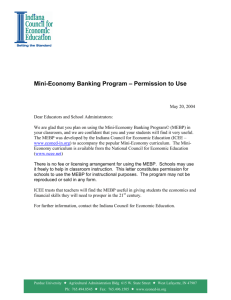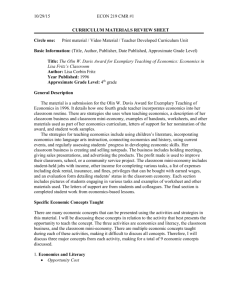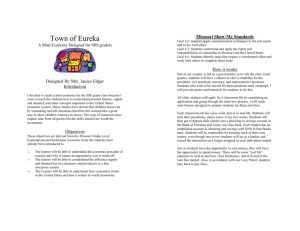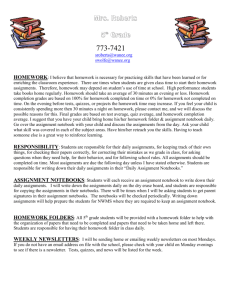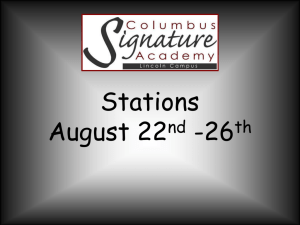Reason 1
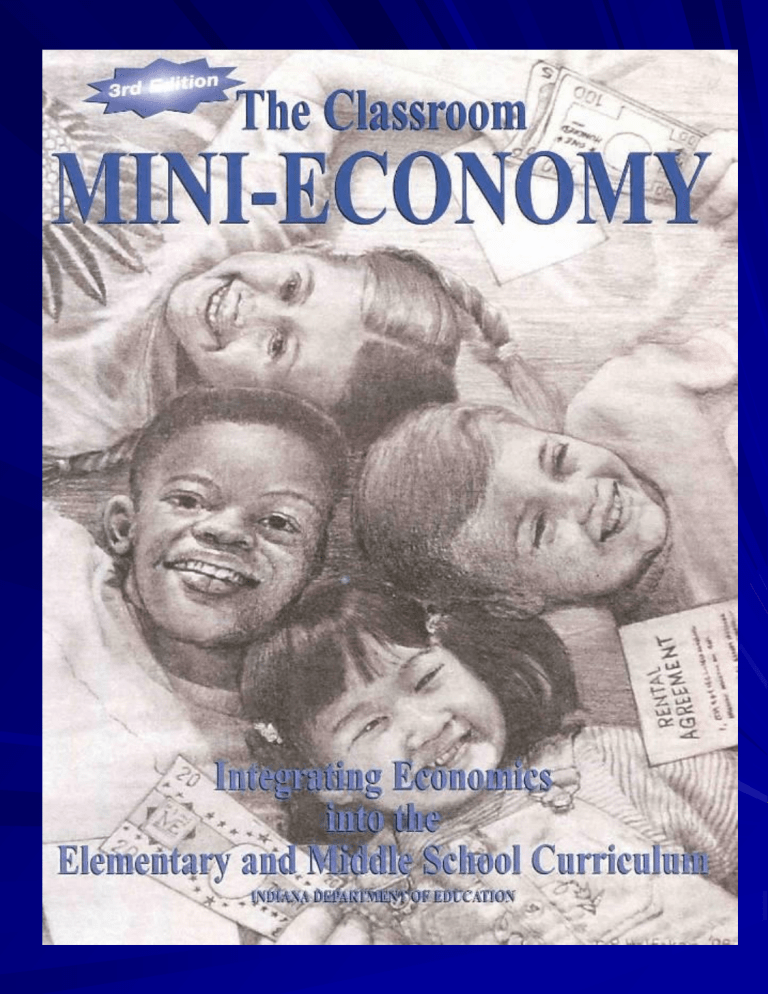
Six Basic Ways to Teach
Economics/Entrepreneurship In
Your Classroom
1. Teaching Activities on Specific
Concepts
2. Classroom Mini-Economies
(Classroom Currency)
3. Classroom Businesses
(Using Real Money)
4. Literature-Based Instruction
5. Using the Stock Market Game
TM
6. Everyday Classroom Situations
What is a Mini-Economy?
And
Why Should I Use One?
The mini-economy is a form of economics instruction in which students participate in a classroom economy in order to simulate real world economic activity.
Five Basic Elements of a Mini-Economy
ECONOMICS INSTRUCTION
CLASSROOM MANAGEMENT
APPLICATION OF BASIC SKILLS
MONEY MANAGEMENT
ENTREPRENEURSHIP
Why Use a
Mini-Economy?
Reason 1: The Mini-Economy Helps
Teach Economic Concepts
Reason 2: The Mini-Economy
Integrates Easily into the
Rest of the Curriculum
Reason 3: The Mini-Economy
Improves Student Learning
• Real as opposed to vicarious
• Active rather than passive
• Actual decision-making and bearing the consequences
Reason 4: The Mini-Economy Models
Our Economic System
Reason 5: The Mini-Economy Is a
Tremendous Motivator
Reason 6: The Mini-Economy Helps
Students Learn How to
Manage Money
Reason 7: The Mini-Economy
Develops Entrepreneurial
Competency
Figure 1-2
Types of Mini-Economies
COMPLEX
I
TEACHER
DIRECTED
●
III
New Mini-Economy
SIMPLE
Kourilsky
II ●
STUDENT
DIRECTED
IV
Three Important Things to Remember
About Operating a Mini-Economy
1.
EXPAND MINI-ECONOMY
ACTIVITIES GRADUALLY
Don’t Try to Do Everything at Once
2.
GIVE STUDENTS RESPONSIBILITY
FOR HANDLING MANY
MINI-ECONOMY DETAILS
Don’t Do What Your Students
Can Do
3.
USE THE MINI-ECONOMY TO
TEACH BASIC ECONOMIC
CONCEPTS
Don’t Use the Mini-Economy
Primarily for Classroom
Management
“My son is one of the students with special needs. His disability – autism – makes it very difficult for him to understand abstract concepts….Through the use of these many different approaches,
Mrs. Salsman has been able to achieve a real breakthrough with my son and teach him so much about the value of money, working, getting paid, spending and saving.
For a child with his disability to have made so much progress in one school year could easily be considered a miracle.
”
Five Steps for Starting a Mini-Economy
Step 1: Design the Classroom Money
Step 2: Decide How Students Will
Earn Money
Classroom Jobs
Payment for Desired Behavior
Mini-Economy Businesses
Classroom Jobs
Payment for Desired
Behavior
Mini-Economy
Businesses
Step 3: Determine What Items and
Privileges the Money Will
Buy
Step 4: Determine How to Distribute
Items and Privileges
Classroom Store
Auction
Step 5: Do It!
Expanding Your
Mini-Economy
Life Necessities
One simple, yet powerful way to add realism to a mini-economy is to require students to pay for various “necessities of life.”
Banks
A bank is a natural for the mini-economy.
See the Mini-Economy Banking Program at http://www.econed-in.org/mebp.asp
Insurance Companies
Insurance is one of the most popular aspects of the mini-economy.
Government and Taxes
Government and taxes are aspects of the mini-economy that are easy to implement.
Real Estate
One of the easiest ways to add realism and excitement into your mini-economy is by introducing the concepts of real estate and private contracts.
Businesses
Many teachers report that mini-economy businesses are the most rewarding and instructive aspect of their mini-economies.
Investments
Adding investments to the mini-economy creates much interest and enthusiasm, and provide an excellent opportunity to use many basic math skills.
Exchange Rates
If there is another mini-economy in your school, it is easy to introduce the concept of exchange rates.
Teaching Economics in the Mini-Economy
Classroom
The mini-economy classroom provides a perfect setting for teaching students the basic economic concepts that are part of the social studies curriculum.
The Actual Classroom
Environment
Economics is an integral part of the world around us and permeates virtually all facets of life, including the elementary and middle school classroom.
Use Everyday Classroom Situations
Use Economics Vocabulary Whenever
Possible
Sample:
The school secretary’s job is important to our school.
The school secretary provides a valuable service to our school.
Existing Curriculum
Economic concepts and themes are found throughout the curriculum.
Social Studies
Language Arts
Math
Economic Education
Materials
There are many excellent economic education materials available to teachers.
KidsEcon Posters
Play Dough Economics Focus: Economics Grade 3-5 www.kidseconposters.com
http://store.ncee.net/playdough http://store.ncee.net/focus35.html
economics.html
